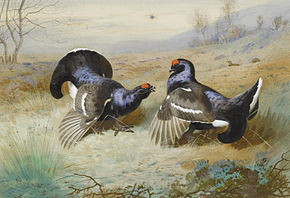
Back اصطفاء زمري Arabic Групов отбор Bulgarian Skupinový výběr Czech Gruppenselektion German Selección de grupo Spanish Grupivalik Estonian انتخاب گروهی Persian Ryhmävalinta Finnish Sélection de groupe French Selección de grupo Galician

Group selection is a proposed mechanism of evolution in which natural selection acts at the level of the group, instead of at the level of the individual or gene.
Early authors such as V. C. Wynne-Edwards and Konrad Lorenz argued that the behavior of animals could affect their survival and reproduction as groups, speaking for instance of actions for the good of the species. In the 1930s, R.A. Fisher and J.B.S. Haldane proposed the concept of kin selection, a form of altruism from the gene-centered view of evolution, arguing that animals should sacrifice for their relatives, and thereby implying that they should not sacrifice for non-relatives. From the mid-1960s, evolutionary biologists such as John Maynard Smith, W. D. Hamilton, George C. Williams, and Richard Dawkins argued that natural selection acted primarily at the level of the gene. They argued on the basis of mathematical models that individuals would not altruistically sacrifice fitness for the sake of a group unless it would ultimately increase the likelihood of an individual passing on their genes. A consensus emerged that group selection did not occur, including in special situations such as the haplodiploid social insects like honeybees (in the Hymenoptera), where kin selection explains the behaviour of non-reproductives equally well, since the only way for them to reproduce their genes is via kin.[2]
In 1994 David Sloan Wilson and Elliott Sober argued for multi-level selection, including group selection, on the grounds that groups, like individuals, could compete. In 2010 three authors including E. O. Wilson, known for his work on social insects especially ants, again revisited the arguments for group selection.[3] They argued that group selection can occur when competition between two or more groups, some containing altruistic individuals who act cooperatively together, is more important for survival than competition between individuals within each group,[3] provoking a strong rebuttal from a large group of ethologists.[2]
- ^ Cite error: The named reference
Tudge2011was invoked but never defined (see the help page). - ^ a b Cite error: The named reference
response to Nowakwas invoked but never defined (see the help page). - ^ a b Nowak, Martin A.; Tarnita, Corina E.; Wilson, Edward O. (August 2010). "The evolution of eusociality". Nature. 466 (7310): 1057–1062. doi:10.1038/nature09205. ISSN 1476-4687. PMC 3279739.
© MMXXIII Rich X Search. We shall prevail. All rights reserved. Rich X Search